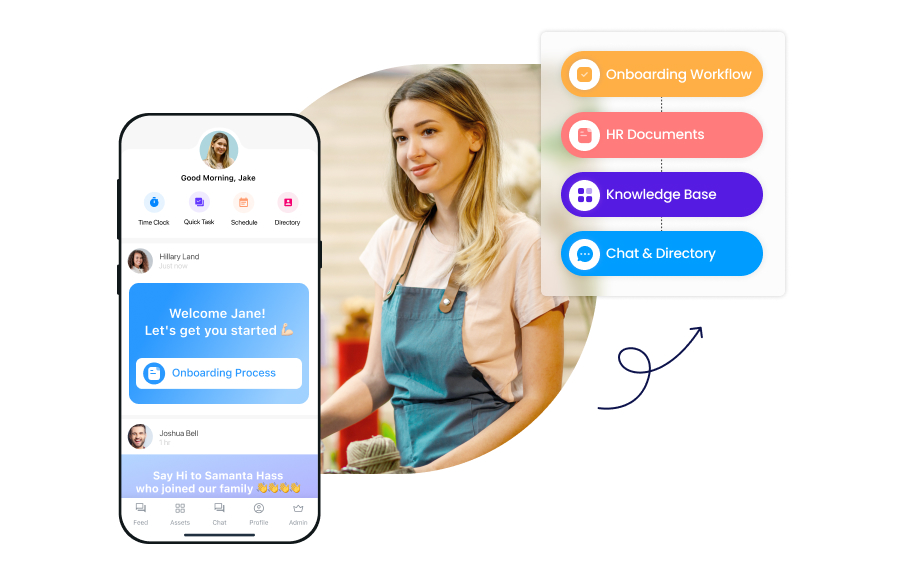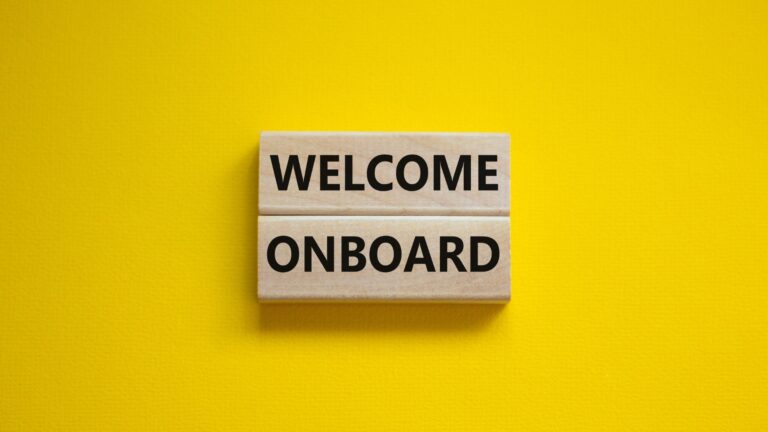Digital onboarding is a great way to get your new hires up to speed quickly, effectively, and affordably. This guide goes over the benefits of digital onboarding, the challenges you may run into, how to optimize the process, and the tools you can use.
Key Takeaways
- With digital employee onboarding, you use tools and technology to onboard new hires. No need for in-person courses, training, or meetings.
- Benefits of onboarding digitally include improved efficiency, cost reduction, and greater convenience.
- Challenges associated with digital onboarding include new employees feeling isolated, finding the process boring, and experiencing information overload.
- Optimize your digital onboarding process by using different types of content, making new hires feel like part of the team, and using a dedicated onboarding app.
Properly onboarding employees helps them understand the scope of their role, get comfortable with their team, and become familiar with your business’s goals and company culture. Without proper onboarding, new employees might struggle to find their place and become disengaged. This can negatively impact their productivity and may even cause them to quit down the line.
Traditional onboarding involves a lot of paperwork, generic procedures, and little ongoing support. It can take a ton of time and effort, and it’s difficult to keep employees engaged throughout the process. Digital employee onboarding, however, changes all that.
In this guide, we explain what digital onboarding is, as well as its advantages and challenges. We also discuss the best tools to use to optimize your digital onboarding process.
What is Digital Employee Onboarding?
Digital employee onboarding involves using tools and technology to onboard new employees. While traditional onboarding is done in person, digital onboarding can be done completely online.
Whether you need to onboard and train employees for a franchise or individual business, companies can use web- or mobile-based onboarding software, like apps or web platforms, to create a fully customized onboarding program. You can use these tools to create and publish training courses, introduce new employees to the team, share policies, gather documentation, and more.
The Benefits of Digital Employee Onboarding
Compared to traditional onboarding, digital onboarding offers many benefits. These include:
Improved efficiency
Traditional onboarding is often a time-consuming process that involves a lot of paperwork and lengthy training sessions. Digital onboarding automates many repetitive tasks and keeps the process moving without delays.
It also enables you to store everything in a database that new hires can access anytime. This allows them to quickly and easily fill out and submit documents and ensures HR staff has all the information they need in one place.
Digital onboarding also allows for an immediate start without the need for an in-person meeting. By the time the new employee starts their first day, they can have all the necessary knowledge and resources to begin working right away.
Reduced costs
With digital onboarding software, you won’t have to worry about the cost of printing and storing onboarding documents or creating and delivering in-person training sessions.
Digital systems let you automatically store and manage employee files within a single location. They also enable you to create and publish comprehensive online training courses, so you don’t have to dedicate time and money to in-person training. You can develop courses in minutes and instantly publish them for new hires to complete.
Digital onboarding can also improve employee retention, which reduces recruiting and hiring costs. A good onboarding experience helps employees feel supported and reinforces the idea that they made a good choice joining your organization. This increases their job satisfaction and decreases the chance of an early exit.
Better convenience
Digital onboarding is convenient for everyone involved. You can access the onboarding software 24/7. New hires can complete onboarding courses at their own pace right from their mobile or desktop devices.
Also, employees won’t have to rifle through stacks of papers to find important information. Within the digital system, they can access any documents they need within seconds.
Additionally, many digital onboarding software solutions have chat functions you can use to provide new hires with ongoing support. You can answer their questions quickly, even after onboarding is complete.
Save time and effort by easily updating onboarding resources
With digital employee onboarding software, you can easily upload new onboarding resources and update existing ones. Add important new documents or files in just a few clicks or taps of your device, or update existing resources in minutes.
Plus, digital onboarding tools are flexible and enable you to customize how you present information. You can easily adjust your process if your onboarding needs or goals change. You can add things like audio, links, videos, quizzes, and various other files, or group certain courses with one another.
This saves you a ton of time and effort, taking the headache out of updating and managing your onboarding process.
Better insight to support employees and optimize your onboarding process
Digital onboarding also allows companies to track employee progress throughout onboarding. Typically, progress is shown on a dashboard.
This dashboard lets you see who has started a course and who’s in progress. It also monitors course completion. This helps you make sure that employees are progressing well and ensures that new hires submit the right documentation on time.
In addition, tracking progress makes it easy to see if employees are struggling with certain onboarding tasks or training courses. You can use this insight to adjust your onboarding materials and fine-tune your process.
This Might Interest You:
Read our in-depth review of the best employee database software for 2025
The Challenges of Digital Employee Onboarding (and How to Counter Them)
While digital employee onboarding has plenty of advantages, there are also some challenges you should be aware of. Here are three of the biggest challenges and how to counter them throughout the training process:
New employees can feel isolated
During digital onboarding, new employees won’t get in-person time with managers or team members. This can lead to them feeling isolated or like they aren’t a “real” part of the team.
How to counter this: You can counter this by routinely checking in with your onboarding employees. With an employee management app like Connecteam, you can message your new employees directly through the in-app chat to check in on their progress. You can also create automatic smart group chats with all your onboarding employees to create a digital space for your new hires to communicate with each other and ask questions.
It can be uninspiring or boring
Onboarding processes often contain little more than an email and a few documents to get a new hire up to speed. They do the job, as employees have the information they need. But they aren’t exciting, and they don’t do a lot for employee engagement.
A basic onboarding process that only involves reviewing policies, filling out paperwork, and reading through documents won’t excite new hires or get them pumped up about their role. This puts them at risk of becoming disengaged, which can lead to decreased productivity and increased turnover.
How to counter this: To keep employees engaged during the onboarding process, incorporate interactive elements, like videos, quizzes, contests, and games–all from the onboarding app. You can reward points or hand out digital badges to foster active participation, motivate employees, and prevent them from getting bored.
New hires can experience information overload
When a new hire is going through onboarding, there’s a lot for them to do and learn. There are documents to review and sign, people to speak with, and duties to understand. This can be very overwhelming for new employees and lead to information overload during their first few days.
How to counter this: One of the best ways to counter information overload is to deliver your digital onboarding training in small, bite-sized pieces. Instead of cramming a ton of information onto a single slide or video, present the information in short increments with a clear beginning and end. Doing so can help prevent employees from information overload and has the added bonus of increasing retention.
Ways to Improve the Digital Onboarding Process
Below are some tips to optimize and improve your digital employee onboarding experience.
Take pre-onboarding seriously
A successful digital employee onboarding process starts with pre-onboarding. This comprises every activity that takes place before the new hire officially starts their first day of work. You need to take pre-onboarding seriously if you want your process to run smoothly.
Pre-onboarding action items might include:
- Setting up the new hire’s email account and/or platform access
- Creating a welcome package
- Sending the employee information such as the company organizational chart or benefits policy
- Informing the rest of the team that a new member is joining.
Use different types of content during onboarding and training
Onboarding can often be less than exciting, so improve your digital onboarding experience by using different types of content.
To help your new hires feel welcome, consider using videos, infographics, and even quizzes to convey important information instead of sending dozens of PDFs or text documents. These can keep onboarding interesting and ensure your new hires stay engaged.
Discuss goals
Sharing a list of goals with employees during onboarding is another great way to optimize your digital onboarding process.
For example, you can create a 30-60-90 day plan for a new hire. This outlines what they’ll do, learn, and accomplish during their first three months in their new job.
However, don’t overwhelm new hires with information or push them to achieve unrealistic goals. Remember that all goals you set for employees should be SMART: specific, measurable, attainable, realistic, and time-bound.
Provide seamless communication throughout the onboarding process
You want to start things off on the right foot with new hires, so make an effort to communicate well with them. You can call, email, text, or chat via your employee management app.
You should also try engaging ways to stay in touch with new hires throughout their onboarding process. You can create fun quizzes, build questionnaires, share GIFs, or come up with ice-breakers to help conversations flow in your employee management app. You could even play a round of trivia or exchange fun facts with new hires.
Additionally, you can consider adding new hires to a group chat so they can talk to coworkers during the onboarding process.
Familiarize new hires with your company culture
According to a Glassdoor survey of 5,000 workers from multiple countries, 56% of respondents said that a good workplace culture was more important than salary for job satisfaction. Therefore, introducing your new hires to your company culture during the onboarding process is crucial.
First, you’ll need to define your company culture. This includes your core values, organizational norms, and the character of your company. It really defines everything from how employees interact with each other to how work gets done.
Make sure you can clearly define your company’s core values and include them in your employee handbook. Make sure to dedicate a specific onboarding training module to explaining the company culture to help new hires integrate into the team.
📚 This Might Interest You:
Read our in-depth guide on how to build a company culture: 9 tips & tricks for managers.
Give new hires a warm welcome
Introduce new employees to the rest of the team via a message in a group chat or a company-wide email to give them a warm welcome. Video conferencing is another great way to accomplish this.
This helps new hires immediately feel a sense of belonging within the company. When they feel this way, they’re much more likely to be engaged at work. This is great for keeping your turnover rate low, as people are less likely to leave a company they’re happy at.For example, with Connecteam, you can officially introduce a new team member on their start date via the company newsfeed. Include a picture and a few fun facts to introduce them to the rest of the time, and coworkers can like and comment to engage with their new team members.
Provide mentors or onboarding buddies
You should also consider providing new hires with a mentor or an “onboarding buddy”. Pair a new employee with a current employee who’s either in their position or who has extensive knowledge of the new hire’s role to ensure they can be as helpful as possible.
With someone to show them the ropes, new employees become accustomed to the job faster and feel less overwhelmed. Plus, this helps them build important relationships with coworkers from the very beginning.
Personalize the experience
Make an effort to personalize the onboarding process. You can do this by onboarding new hires differently based on their role. For example, independent contractors will need onboarding information on billing and benefits that’s different from what part-time and full-time employees receive. Meanwhile, supervisors will need onboarding focused on company policies and processes, so they can properly supervise staff.
You might also tailor employees’ onboarding experiences based on their learning styles. For example, you could implement different onboarding methods for auditory and visual learners. You could have videos or audio recordings explaining certain duties and policies for auditory learners. And you could have infographics and step-by-step visual guides for visual learners.
During pre-onboarding, you can send a questionnaire and ask new hires how they prefer to learn. Then, you can use the appropriate onboarding methods to make their experience a positive one.
Use an app for onboarding
Onboarding employees digitally is easier when you use a dedicated app or software solution.
With digital employee onboarding software, you can create training courses quickly and easily, and new hires can complete them on their mobile or desktop devices. Employees can also review and sign documents and access company knowledge bases.
As an employer, you can use tracking tools to gain insight into how new hires are progressing through onboarding. You can also set deadlines for onboarding tasks and send instant notifications to new hires to complete them. Some onboarding apps also have live polls, surveys, and suggestion boxes that can help you gain valuable feedback.
Best of all, you and your employees can use an onboarding app from anywhere, at any time.
Best Tools for Digital Employee Onboarding
Speaking of apps, let’s go over a few of the best tools for digital employee onboarding.
Connecteam is an award winning all-in-one onboarding solution and work management system.

It lets you design your own onboarding program in just a few clicks. You can manage the entire onboarding process right from within the Connecteam app. New employees can go through onboarding directly from the app, too! They can work at their own pace and complete onboarding from wherever they want.
Connecteam also makes course creation simple. You can divide courses into smaller sections so new hires aren’t overwhelmed with too much information at once.
With Connecteam’s employee training software you can fully customize course content and structure and make updates with ease. Connecteam has customizable quizzes, surveys, and forms you can use to ensure new hires are retaining knowledge. Plus, you can easily add videos, PDFs, links, and other materials to your courses. Better yet, Connecteam allows you to reuse your onboarding materials and update them whenever you need to.
In addition, Connecteam lets you gather documentation from new hires and set deadlines and reminders for course completion. You can also automatically send out onboarding courses to the right people based on when their role or start date.
Connecteam also makes it simple to track employees’ onboarding progress in real time. You can also see who has completed training courses. These insights help you spot potential problem areas, so you can make data-driven decisions to improve your onboarding process.
Connecteam’s surveys, polls, and HR suggestion box feature also enable you to collect valuable feedback from employees.
In addition, Connecteam’s in-app chat makes it easy for new hires to ask questions, get answers, and communicate with the wider team.
Connecteam’s employee time tracking software is another great feature for onboarding and beyond. It has a time clock that’s accurate to the second, so employees are always paid correctly.
Connecteam starts at just $29 per month for 30 users. It offers a free trial and a free-forever plan for small businesses with up to 10 users.
Zenefits
Zenefits is an HR software solution for managing hiring, onboarding, and employee records. The platform can automate HR processes and offers self-onboarding so new hires can onboard before they clock into work for the first time.
Zenefits also offers the ability to customize onboarding, send job offers, perform background checks. It also simplifies signing documents such as contracts. It can handle benefits and payroll, and lets administrators track onboarding progress.
Zenefits starts at $8/employee/month for the basic package. It offers a free demo but doesn’t have a free plan.
Bamboo HR
Bamboo HR is a digital solution for customizing the employee experience during onboarding.
It enables business owners and managers to build onboarding templates, create an employee database, assign tasks, and track progress. Bamboo HR also helps gather employee signatures and can simplify repetitive onboarding tasks. It can also be integrated with other work management tools and apps.
Bamboo HR doesn’t list its prices publicly. Instead, businesses must reach out and ask for a price quote.
While Bamboo HR does offer a free trial, it doesn’t have a free plan.
Conclusion
Improper onboarding can frustrate and confuse new hires, which can lead to early exits from your company. Digital onboarding makes the process more efficient, cost-effective, and convenient for everyone involved.
While there are challenges that come with digital onboarding, you can tackle them by optimizing your process. You can do this by using different types of content, assigning new hires with onboarding mentors, discussing goals, and more.
One of the best ways to create a digital employee onboarding program is to use a dedicated software solution, like Connecteam. You can get your new hires up to speed as efficiently as possible and ensure they feel engaged from the start.




